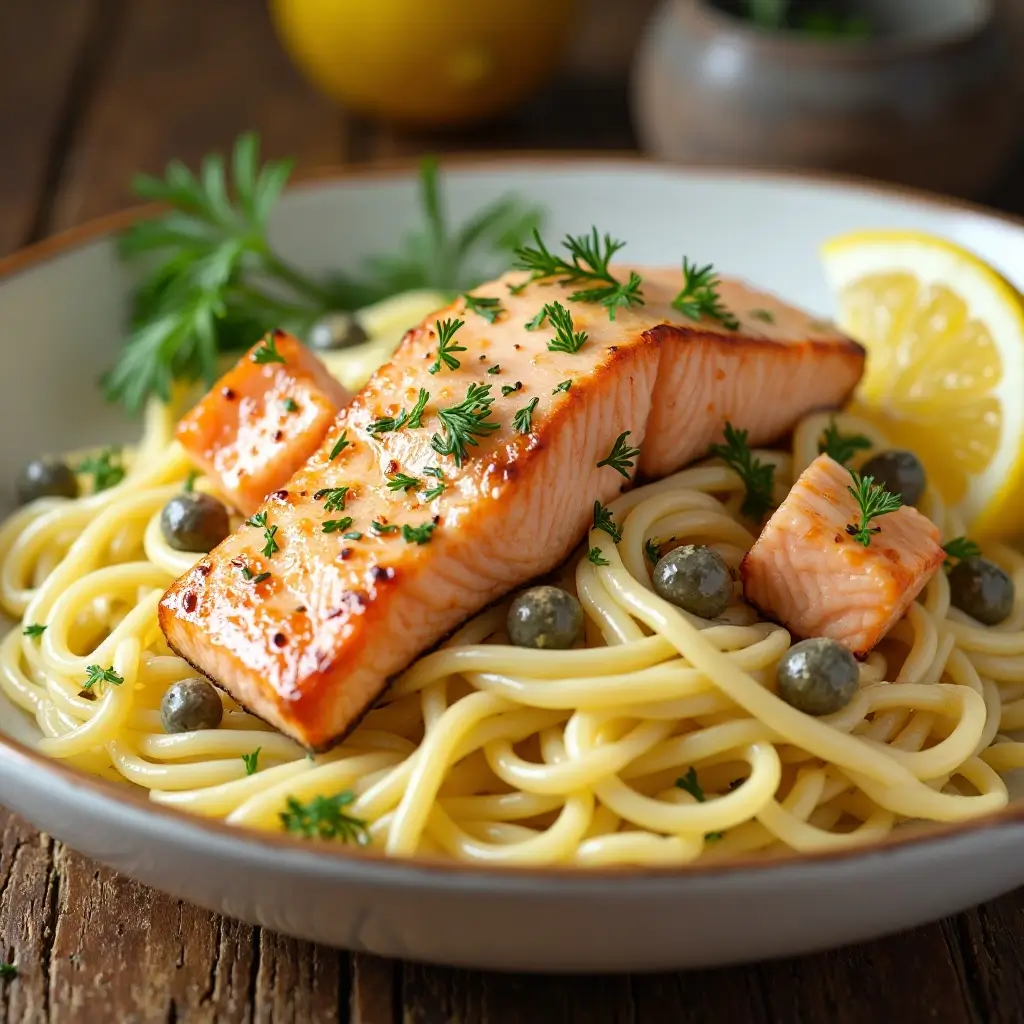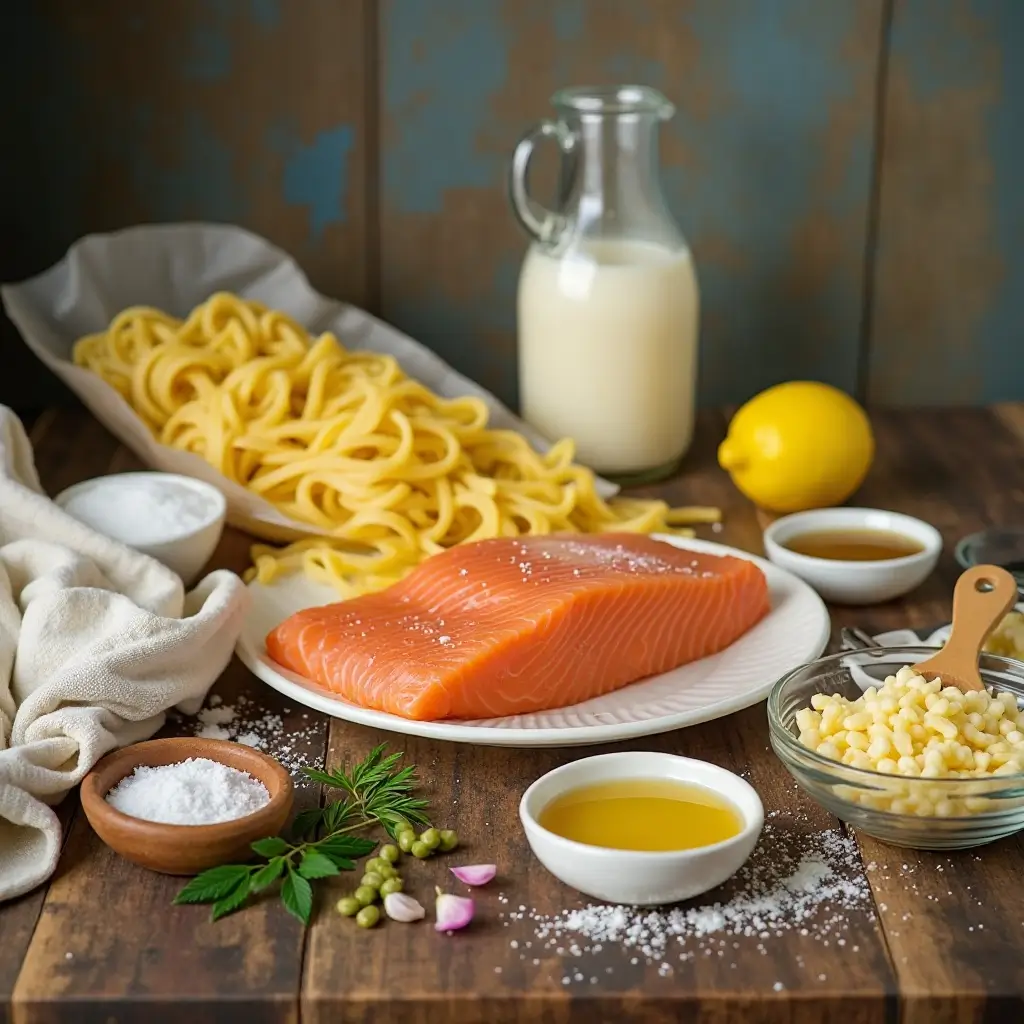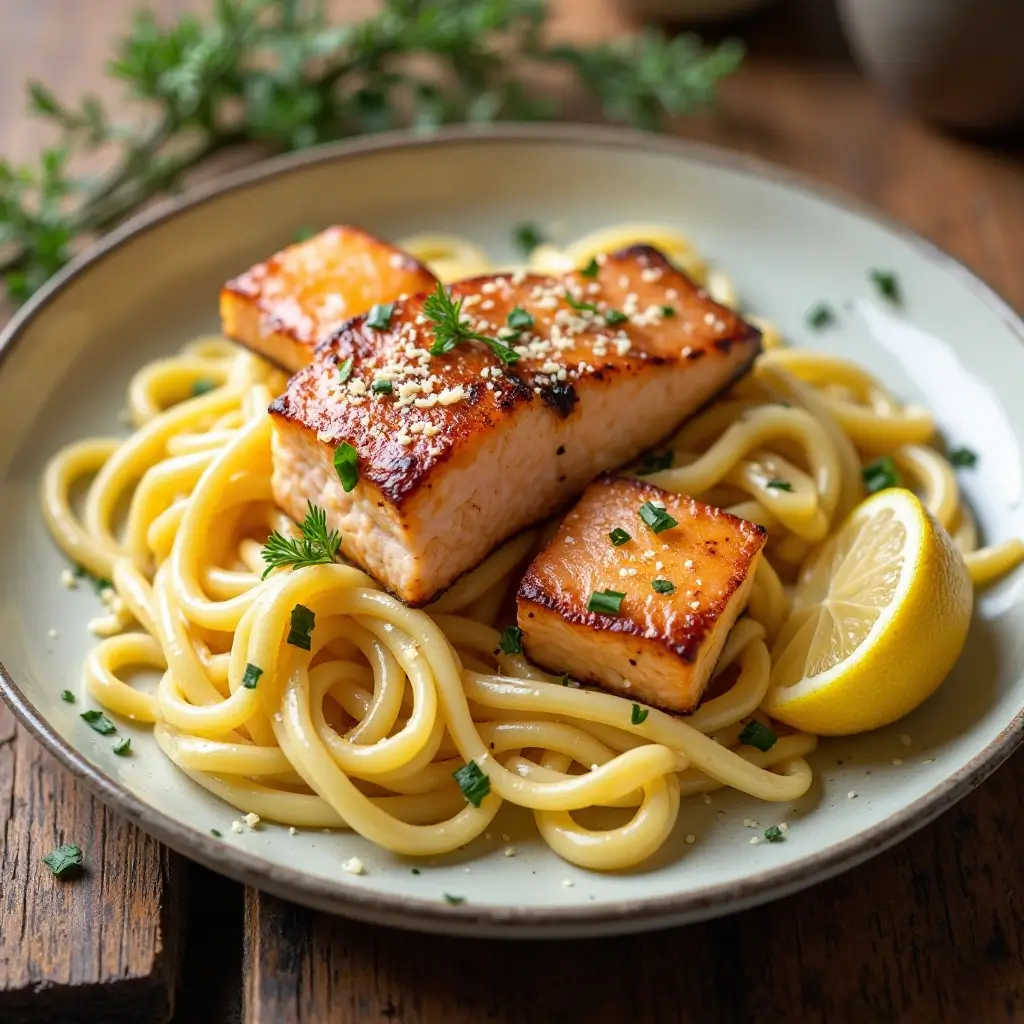Simple Salmon Noodles 20 Minute Recipe
Imagine twirling silky noodles coated in a luxurious, creamy sauce with tender chunks of perfectly cooked salmon in every bite. These creamy salmon noodles are pure comfort food magic that transforms simple ingredients into restaurant-quality elegance right in your own kitchen.
Here’s a fun fact: salmon paired with pasta became popular in Italian-American cuisine during the 1960s when home cooks discovered how beautifully the rich fish complemented cream-based sauces. This dish is special because it delivers gourmet flavors in just 20 minutes, making it perfect for busy weeknights when you want something impressive yet effortless.
Much like our popular garlic butter shrimp pasta, this recipe proves that seafood and noodles create magical combinations that please the whole family.
Table of Contents
What is Salmon Noodles?
Ever wondered why we call this heavenly combination “salmon noodles”? Well, sometimes the best names are the most straightforward ones! This dish is essentially tender egg noodles or pasta swimming in a velvety cream sauce studded with flaky salmon pieces. The name might sound simple, but don’t let that fool you – this recipe packs serious flavor punch.
As they say, “the way to a man’s heart is through his stomach,” and these salmon noodles are definitely heart-winning material! Ready to fall in love with your new favorite weeknight dinner?
Why You’ll Love This Salmon Noodles Recipe
Rich and Creamy Perfection
The star of this dish is undoubtedly the luscious cream sauce that envelops every strand of pasta. Made with heavy cream, butter, and aromatic garlic, this sauce creates a restaurant-quality base that rivals any upscale dining experience. The salmon adds a delicate, buttery flavor that melts in your mouth, while fresh herbs like dill or parsley brighten the entire dish.

Budget-Friendly Luxury
Making salmon noodles at home costs a fraction of what you’d pay at a restaurant. A single salmon fillet can serve 3-4 people when paired with pasta, making this an economical way to enjoy premium seafood. You’ll save money while controlling the quality of ingredients, ensuring your family gets the best without breaking the bank.
Flavorful Toppings and Ingredients
What makes these salmon noodles extraordinary are the finishing touches. A squeeze of fresh lemon juice adds brightness, while capers provide delightful briny pops of flavor. Freshly cracked black pepper and a sprinkle of parmesan cheese elevate this dish from simple to sublime. Similar to our beloved creamy chicken alfredo, this recipe shows how the right combination of ingredients creates pure magic.
Ready to create this masterpiece in your own kitchen? Let’s get cooking!
How to Make Salmon Noodles
Quick Overview
This salmon noodles recipe delivers maximum flavor with minimal effort. The key to success lies in perfectly timing the pasta cooking with the cream sauce preparation.
Prep Time: 10 minutes
Cook Time: 15 minutes
Total Time: 25 minutes
Servings: 4
The beauty of this dish is its simplicity – while the pasta boils, you’ll create a silky cream sauce and gently cook the salmon to flaky perfection.
Key Ingredients for Salmon Noodles
For the Pasta:
- 12 oz egg noodles or fettuccine pasta
- 1 tablespoon salt (for pasta water)
For the Salmon:
- 1 lb fresh salmon fillet, skin removed and cut into 1-inch cubes
- 2 tablespoons olive oil
- Salt and black pepper to taste
For the Cream Sauce:
- 3 tablespoons butter
- 3 cloves garlic, minced
- 1 cup heavy cream
- ½ cup chicken broth
- ½ cup freshly grated parmesan cheese
- 2 tablespoons fresh lemon juice
- 2 tablespoons fresh dill, chopped
- 1 tablespoon capers (optional)
- Salt and white pepper to taste

Step-by-Step Instructions
Step 1: Prepare the Pasta Water
Fill a large pot with water and add 1 tablespoon of salt. Bring to a rolling boil over high heat. The salted water will flavor the pasta from within, creating a more delicious base for your dish.
Step 2: Cook the Pasta
Add the egg noodles to the boiling water and cook according to package directions until al dente, usually 8-10 minutes. Reserve 1 cup of pasta cooking water before draining, as this starchy liquid will help bind your sauce perfectly.
Step 3: Season and Cook the Salmon
While the pasta cooks, pat the salmon cubes dry with paper towels. Season generously with salt and pepper on all sides. Heat olive oil in a large skillet over medium-high heat. Add salmon pieces and cook for 2-3 minutes per side until golden brown and cooked through. Remove salmon to a plate and set aside.
Step 4: Create the Cream Sauce Base
In the same skillet, reduce heat to medium and add butter. Once melted, add minced garlic and sauté for 30 seconds until fragrant. Be careful not to burn the garlic as it will become bitter.
Step 5: Build the Sauce
Pour in the chicken broth and let it simmer for 2 minutes. Slowly add the heavy cream while whisking constantly to prevent curdling. Let the mixture simmer gently for 3-4 minutes until it begins to thicken slightly.
Step 6: Add Cheese and Seasonings
Remove the skillet from heat and gradually whisk in the parmesan cheese until melted and smooth. Add lemon juice, fresh dill, and capers if using. Season with salt and white pepper to taste.
Step 7: Combine Everything
Add the drained pasta to the cream sauce and toss gently to coat. If the sauce seems too thick, add reserved pasta water one tablespoon at a time until you reach the desired consistency. Gently fold in the cooked salmon pieces, being careful not to break them apart.
Step 8: Final Touches and Serve
Transfer to serving bowls and garnish with additional fresh dill, a sprinkle of parmesan cheese, and freshly cracked black pepper. Serve immediately while hot and creamy.
What to Serve Salmon Noodles With
Fresh Salads: A crisp Caesar salad or mixed greens with lemon vinaigrette perfectly balances the richness of the cream sauce. The acidity cuts through the heaviness while adding fresh textures.
Vegetable Sides: Roasted asparagus, steamed broccoli, or sautéed spinach complement the salmon beautifully. These green vegetables add color, nutrients, and a pleasant contrast to the creamy pasta.
Bread Options: Warm garlic bread or crusty sourdough rolls are perfect for soaking up any remaining sauce. A simple bruschetta with tomatoes and basil also pairs wonderfully.
Wine Pairings: A crisp white wine like Pinot Grigio, Chardonnay, or Sauvignon Blanc enhances the salmon’s delicate flavor without overwhelming the dish.

Top Tips for Perfecting Salmon Noodles
Choose Quality Salmon
Fresh, wild-caught salmon delivers the best flavor and texture. Look for bright orange-pink color and firm flesh. If using frozen salmon, thaw completely and pat very dry before cooking to prevent excess moisture in your sauce.
Don’t Overcook the Salmon
Salmon continues cooking from residual heat even after removing from the skillet. Cook just until it flakes easily with a fork – about 3-4 minutes total. Overcooked salmon becomes dry and tough.
Control the Sauce Consistency
If your sauce becomes too thick, thin it with reserved pasta water rather than plain water. The starchy pasta water helps bind the sauce to the noodles better. Add it gradually, one tablespoon at a time.
Ingredient Substitutions
- Heavy cream can be replaced with half-and-half for a lighter version
- Use gluten-free pasta for dietary restrictions
- Substitute Greek yogurt mixed with a little pasta water for a healthier cream sauce
- Fresh herbs like parsley or chives work well instead of dill
Temperature Matters
Serve immediately while the sauce is hot and creamy. Cold cream sauces tend to separate and become less appealing in texture and appearance.
Storing and Reheating Tips
Refrigerator Storage: Store leftover salmon noodles in the refrigerator for up to 3 days in an airtight container. The cream sauce may separate slightly, but this is normal and will come together when reheated properly.
Reheating Instructions: For best results, reheat gently in a skillet over low heat, adding a splash of milk or cream to restore the sauce’s silky texture. Stir frequently to prevent sticking and ensure even heating. Alternatively, microwave in 30-second intervals, stirring between each interval.
Freezing Guidelines: While possible to freeze for up to 2 months, cream-based sauces can separate when thawed. If freezing, place in freezer-safe containers and thaw overnight in the refrigerator before reheating. You may need to add extra cream when reheating to restore the original texture.
Make-Ahead Tips: Prepare the sauce and salmon separately, storing them in the refrigerator for up to 2 days. Cook fresh pasta when ready to serve and combine everything while hot for the best results.
Nutrition Information
| Nutrient | Per Serving |
|---|---|
| Calories | 485 |
| Protein | 32g |
| Carbohydrates | 42g |
| Fat | 22g |
| Fiber | 2g |
| Sodium | 650mg |
| Omega-3 Fatty Acids | 1.8g |
Nutritional values are approximate and may vary based on specific ingredients used.
Frequently Asked Questions
Can I use canned salmon instead of fresh?
Yes, you can substitute canned salmon, but drain it well and add it at the very end to prevent it from breaking apart too much. Fresh or frozen salmon provides better texture and flavor.
What type of noodles work best for this recipe?
Egg noodles, fettuccine, or penne pasta work excellently. Choose a pasta shape that holds sauce well. Wide, flat noodles are ideal for cream sauces.
How do I prevent the cream sauce from curdling?
Keep the heat at medium or lower when adding cream, and never let the sauce boil vigorously. Adding cream slowly while whisking helps maintain a smooth consistency.
Can I make this recipe dairy-free?
Yes, substitute heavy cream with coconut cream and use nutritional yeast instead of parmesan cheese. The flavor will be different but still delicious.
Why is my sauce too thin?
If your sauce is thin, simmer it longer to reduce and thicken. You can also mix 1 tablespoon of cornstarch with cold water and whisk it into the simmering sauce.
How do I know when the salmon is perfectly cooked?
Salmon is done when it flakes easily with a fork and reaches an internal temperature of 145°F (63°C). The flesh should be opaque and slightly pink in the center.
Can I add vegetables to this dish?
Absolutely! Spinach, peas, cherry tomatoes, or mushrooms make excellent additions. Add heartier vegetables like mushrooms with the salmon, and delicate ones like spinach at the very end.
What’s the best way to reheat leftovers without the sauce separating?
Reheat gently over low heat, stirring frequently, and add a splash of cream or milk to restore the smooth texture. Avoid high heat which can cause separation.
Final Thoughts
These creamy salmon noodles represent the perfect marriage of simplicity and elegance. With just a handful of quality ingredients and 25 minutes of your time, you can create a restaurant-worthy meal that will have your family asking for seconds. The combination of tender salmon, silky noodles, and luxurious cream sauce proves that some of the best recipes are also the most straightforward.
Remember, cooking is about creating memories and bringing people together around the dinner table. This salmon noodles recipe does exactly that – it transforms an ordinary weeknight into something special. Whether you’re cooking for your family or entertaining guests, this dish delivers impressive results every single time.
Don’t forget to save this recipe and share it with friends who love quick, delicious meals. Happy cooking, and enjoy every creamy, satisfying bite of your homemade salmon noodles!
